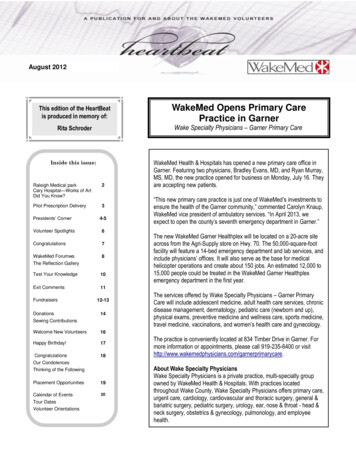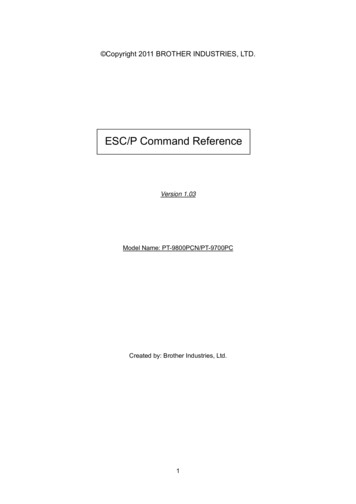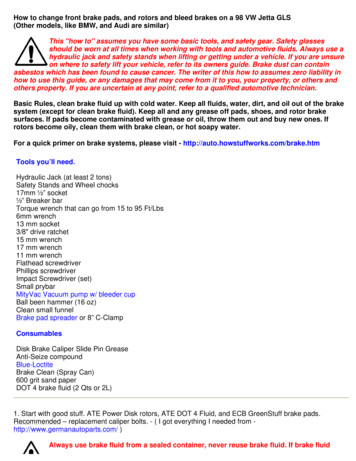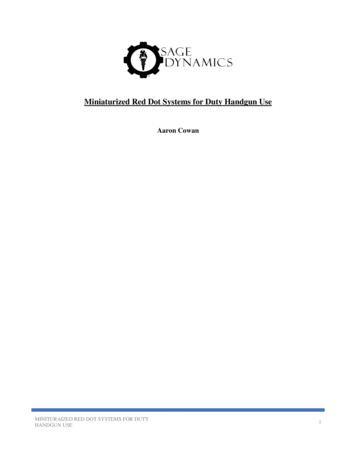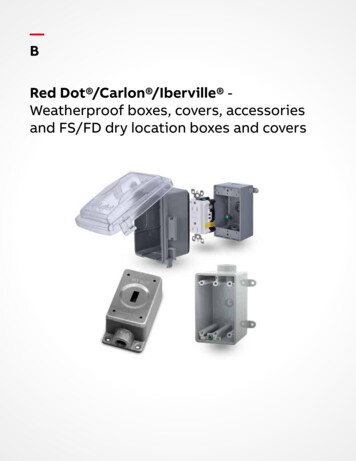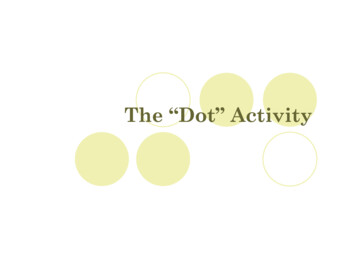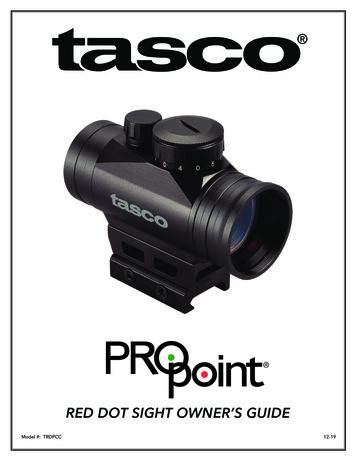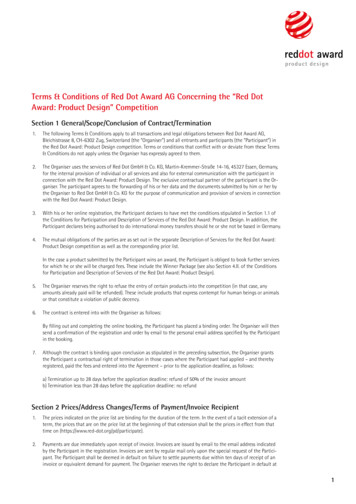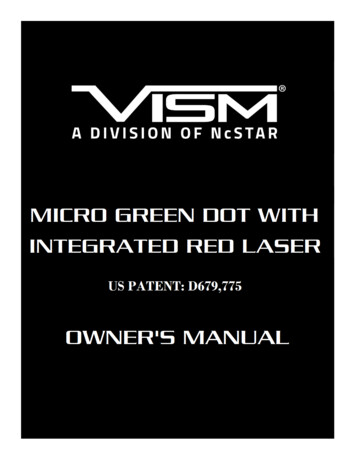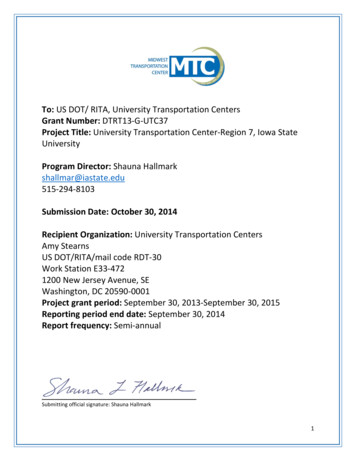
Transcription
To: US DOT/ RITA, University Transportation CentersGrant Number: DTRT13-G-UTC37Project Title: University Transportation Center-Region 7, Iowa StateUniversityProgram Director: Shauna Hallmarkshallmar@iastate.edu515-294-8103Submission Date: October 30, 2014Recipient Organization: University Transportation CentersAmy StearnsUS DOT/RITA/mail code RDT-30Work Station E33-4721200 New Jersey Avenue, SEWashington, DC 20590-0001Project grant period: September 30, 2013-September 30, 2015Reporting period end date: September 30, 2014Report frequency: Semi-annualSubmitting official signature: Shauna Hallmark1
1. AccomplishmentsMajor Goals and ObjectivesMTC’s theme is Data Driven Performance Measures for Enhanced Infrastructure Condition, Safety, andProject Delivery and will address related regional issues through a strategically focused program that issynergistic with U.S. DOT priorities and MAP-21 goals and objectives, with State of Good Repair as theprimary goal. The objectives of the MTC are to Serve as a focal point within the region and nationally for research that develops data performancemeasures for Infrastructure Condition, Safety, and Project Delivery.Ensure efficient use of funds by building on existing programs, avoiding duplication, leveragingexisting resources, and developing creative cooperative activities with industry.Develop products that are useful and relevant to stakeholders including regional, national, state,regional, and local transportation agencies as well as industry and other researchers.Provide leadership in the next generation of technology transfer. Beginning with the researchitself—involving the user, innovative outreach, and new communications technology (i.e., phoneapps).Develop the next generation of transportation professionals and provide opportunities for currentprofessionals.Provide leadership opportunities for students and young professionals.Recruit and retain a diverse workforce.Accomplishments Toward the GoalsStudy AbroadMTC has planned a study abroad opportunity in Istanbul, Turkey, for May 2015. The course is titled“Advanced Topics in Transportation Engineering,” and instructors will be Dr. Hallmark, Dr. Smadi, Dr.Williams, and Dr. Ceylan. The study abroad program is geared towards students in civil, construction,and environmental engineering. All instructors are professors of Civil, Construction, and EnvironmentalEngineering at Iowa State University (ISU) and affiliated with MTC. The ISU professors will be present forthe duration of the two-week course. Visiting professors from Boğaziçi University (Turkey) will alsoparticipate. Students from ISU and all partner universities will be invited to participate in this excitingopportunity.Transportation engineering is an increasingly global profession. Through this course, students will beginto gain an understanding of the impacts of different engineering, historical, cultural, social, economic,ethical, environmental, and political conditions on the design and construction of various infrastructureprojects outside the United States. In addition, this course will help students prepare for future careersin engineering firms and academia as well as in the non-profit arena, including local, state, federal, andinternational governments and entities. Specific topics include the following: History of transportation in Roman, Latin, Byzantine, and Ottoman empiresAddressing transportation problems in a large metropolitan area2
Comparing U.S. and international traffic safetyMega transportation projectsPublic transportationPresentations about the study abroad program were made at a graduate student welcome night hostedby the Department of Civil, Construction, and Environmental Engineering (September 11, 2014). Theprogram was also presented at two orientation meetings for graduate/undergraduate students workingat the Institute for Transportation (InTrans).Flyers and posters were developed and are being distributed to all junior- and senior-level classes incivil, construction, and environmental engineering. An open house is planned for the beginning ofNovember. The team has met with ISU Study Abroad program staff, who are very enthusiastic aboutfinally having a program in civil engineering.Go! Online Magazine (Workforce Development)Go! magazine, along with its Spanish counterpart ¡Vamos!, aims to develop the transportationworkforce by educating and stimulating young minds about the vast educational and career possibilitiesin transportation. During this term, Go! magazine has begun a major transformation of its website toallow for better access to its articles, videos, and features. Publishing four articles each month, thestudent staff at Go! write about transportation from a variety of angles. In addition, to better provideoutreach to STEM teachers, an email-based newsletter has been developed with plans to be distributedonce each month starting in November.Although still being developed, in the next term Go! will be implementing a “My Mentor” video seriesand a web comic tilted “Dot’s Adventures with Transportation,” which follows teenager Dot as shelearns about the transportation field.Go! magazine has also recently partnered with the Iowa Department of Transportation as it attempts toprovide K–12 outreach through the AASHTO TRAC & RIDES programs. Go! will help provide deliverables(such as videos) in this outreach attempt.AASHTO TRAC & RIDES (Workforce Development)MTC and the Accelerated Bridge Construction University Transportation Center at Florida InternationalUniversity partnered with the Iowa DOT to pilot the AASHTO TRAC program at four central Iowa schools.Education is a key element of the activities conducted by InTrans for the MTC and the AcceleratedBridge Construction University Transportation Center, and this partnership will be valuable for bothparties.Transportation and Civil Engineering modules or TRAC PACs, an AASHTO educational outreach program,is designed for use in STEM classes. Their hands-on activities introduce students in grades 7–12 to thework world of transportation and civil engineering and inspires them to consider careers in those fields.The TRAC program is aligned with national standards and is currently being aligned with Core CurriculumStandards of Learning.3
MTC is leading the program with a matching grant from the Iowa DOT. The following are the majoractivities for Phase I of the program: Identify states that have successfully implemented AASHTO TRAC & RIDESSelect and review TRAC kits (the team has selected three potential kits that will be reviewed by highschool math and science teachers)Identify pilot study locationsImplement the program in two to four schoolsDevelop a list of transportation professionals to serve as resources to teachersAn informational session for teachers will be hosted at ISU in late spring or early summer 2015 to giveteachers and researchers the opportunity to review the materials together, discuss how these activitiesalign with the national standards for math and science, and determine which additional TRAC PACsshould be purchased for the 2015–2016 school year. Interest is also being explored in the AASHTO RIDESprogram (Roadways Into Developing Students), which caters to K–8 elementary and middle schoolclasses.MTC Scholars ActivitiesIn this term MTC Scholars engaged in a wide range of activities.Paige March, an undergraduate MTC Scholar, presented a poster on DDI interchange safety followingselection for the University of Missouri System Undergraduate Research Day at the Capitol in March.A graduate student class of MTC Scholars from the University of Missouri attended the IntelligentTransportation Systems Meeting in St. Louis, Missouri, in March.First and second place in the annual postercompetition at the annual Missouri Traffic and SafetyConference in May were won by MTC Scholars: First place: Yi Hou, “Traffic Flow Forecasting forUrban Work Zones”Runner up: Tim Cope, “Motorist Alarm for MovingW-Z Operations”On June 29–July 2, five civil engineering graduate MTCScholars from ISU attended the Joint Western-Midwestern ITE meeting in Rapid City, South Dakota,where they competed in the annual Traffic Bowl. The team achieved second place this year. MTC ScholarGeorges Bou-Saab also presented during the research poster competition.4
Ten MTC Scholars from ISU attended the annual fallMOVITE meeting on September 17–19, where theywere awarded the “Best Student Chapter Award” foroutstanding achievement as an ITE chapter. During themeeting, Yundi Huang was also awarded second placein the 2014 Thomas J. Seburn Student PaperCompetition for her paper entitled “Analysis of Riskyand Aggressive Driving Behaviors Among AdultIowans”. For this honor she was given a 500honorarium.Collaborative Research EffortsDr. Sharma and Dr. Nath had a brainstorming meeting about potential collaborative projects in earlyJune of 2014. Based on the discussion, the City of Omaha Arterial Signal Timing Evaluation project wasidentified as a potential candidate. The City of Omaha is in the process of procuring an adaptive controlsystem to improve the operations of Dodge Street. Dr. Sharma and Dr. Nath saw potential where trafficengineering skills can be combined with economic benefit-cost evaluations to assess the investment thecity is making in procuring the system. Dr. Sharma and Dr. Nath then arranged a meeting with the City ofOmaha Traffic Engineer, Mr. Murthy Koti, to discuss the idea. Mr. Murthy Koti was very positive aboutthe idea and suggested an open RFP. The RFP will come out in early in 2015. Dr. Sharma and Dr. Nathwill collaboratively put in a proposal for the RFP.In addition, the MTC is coordinating with the Center for Advanced Infrastructure and Transportation(CAIT) at Rutgers. CAIT has successfully won a national center with a focus on state of good repair, whichis similar to the MTC theme. We invited Dr. Ali Maher, CAIT Director, to speak at our spring seminar andto discuss collaboration on future activities.Year 2 ResearchThe MTC partners have utilized year 2 funding to further develop their research projects. The ISU teamworked with both Wichita State University and Creighton University to help them develop atransportation-focused research program. The University of Missouri-Columbia (UMC) and theUniversity of Missouri-St. Louis (UMSL) worked with Harris-Stowe University to develop its researcheffort. The following guidelines were used to finalize the funded research projects: Whether the topic aligned with the MTC themePositive recommendation from subject matter expertsInvolvement of studentsAmount and type of matching fundsRegional and national significanceIowa State University held a research open house on October 9, 2014. All faculty and staff were invitedto attend this event to receive additional information and ask any questions about funding for futureresearch projects.The tables below list the ISU research program in addition to the research program at partnerinstitutions. All projects are underway, and each semi-annual progress report will include an update on afew projects.5
Project TitleAn Examination of How Firm Size Affects the SafetyPerformance of Commercial Drivers in the U.S. MotorCarrier IndustryBio-cement for Road RepairIowa State University Funded MTC ProjectsPI NameCantor, DavidDepartmentSupply Chain & Information Systems, IowaState UniversityStudents1- UndergraduateChu, JianCivil, Construction & EnvironmentalEngineering, Iowa State UniversityIndustrial & Manufacturing SystemsEngineering, Iowa State UniversityAgricultural & Bio-systems Engineering,Iowa State University1- PhD AssistantInstitute for Transportation, Iowa StateUniversityInstitute for Transportation, Iowa StateUniversityInstitute for Transportation, Iowa StateUniversityInstitute for Transportation, Iowa StateUniversity1- 1/2 time MastersCivil, Construction & Environmental Eng,Iowa State UniversityInstitute for Transportation, Iowa StateUniversity1- PhD EngineeringInstitute for Transportation, Iowa StateUniversityInstitute for Transportation, Iowa StateUniversityCivil, Construction & Environmental Eng,Iowa State UniversityCivil, Construction & Environmental Eng,Iowa State University2- Eng Graduates 1- StatsMS Assistant1-1/4 time Masters6Data Driven Highway Infrastructure ResilienceAssessmentResearch, Education and Development (RED) ExaminingCharacteristics of Roadway Infrastructure in Various 3DVisualization ModesUsing Operational Data to Access Mobility and CrashExperience During Winter ConditionsHigh Friction Surface Treatment for High CrashLocationsEvaluation of Temporary Rumble StripsGuiping, HuDevelopment of Rural Road Bridge Weigh-in-MotionSystem to Assess Weight and Configuration of Farm toMarket VehiclesTerrestrial Laser Scanning-Based Bridge StructuralCondition AssessmentIntegration of Structural Health Monitoring intoMultilayer Statewide Bridge Maintenance andManagement PracticesDevelopment of Crash Modification Factors for LaneDeparture CountermeasuresRisk-Based Bridge Management: A Methodology toAssess and Incorporate Risk in Decision-MakingDevelopment and Evaluation of Portable Device forMeasuring Curling and warping in Concrete PavementsAssessing Segment and Corridor-Based Travel TimeReliability on Urban FreewaysDahlberg, JustinHistorical Performance Evaluation of Iowa PavementTreatments Using Data AnalyticsJeong, DavidKeren, NirHans, ZachHans, ZachHawkins, NealTurkan, YeldaPhares, BrentHallmark, ShaunaAldemir-Bektas, BasakCeylan, HalilDong, JingCivil, Construction & Environmental Eng,Iowa State University1- Masters1- PhD Assistant 1Undergraduate1- Masters1- MS Assistant1- Research Assistant1- Research Assistant1- Research Assistant 3undergraduates1- Masters1-PhD1-undergraduate1- PhD Assistant
Project TitlePrevious Concrete Physical Characteristics andEffectiveness in Stormwater Pollution ReductionDeveloping Green, Highly Flowable, Rapid Set, HighPerformance Concrete for Pavement Patch RepairToward Autonomous and Robotic InfrastructureConstruction: A Workshop and Field Studies ofProductivity, Quality and Safety ImpactsDevelopment of a Mix Formation and Pavement DesignUsing Asphalt-Rubber BindersData Driven Urban Traffic Prediction for WinterPerformance MeasurementsEconomic Impact of Multi-Span, Pre-Stressed ConcreteGirder Bridges Designed as Simple Span vs ContinuousSpanPI NameOng, Say KWang, KejinWhite, DavidWilliams, ChrisZhu, ZhengyuanHosteng, TravisDepartmentCivil, Construction & Environmental Eng,Iowa State UniversityCivil, Construction & Environmental Eng,Iowa State UniversityCivil, Construction & Environmental Eng,Iowa State UniversityStudents1-PhD1- 1/4 time Masters1-Research Assistant 1Undergraduate1-Research Assistant 4UndergraduatesInstitute for Transportation, Iowa StateUniversityStatistics, Iowa State University1-Research AssistantInstitute for Transportation, Iowa StateUniversity1- Research Assistant1- Statistics Masters7
Project TitleHSSU Transportation Asset Management ResearchProjectAsset Utilization and Management in the AirportGround Transportation IndustryMass Transit Sustainability in the Saint Louis RegionSubcontractors on Funded MTC ProjectsPI NameFara ZakeryRay MundyRay MundyTrucking & Rail Intermodal Hub in the Saint LouisRegionSafety and Operations Data: Visualization andCommunicationPavement Performance: New Approaches using DataAnalyticsBridges for LifeRay MundyThe Technology ProjectNemmers, CharlesA Decision Support System for DOT Fleet OperationsNemmers, CharlesRisk and Failure Resilience Quantification ofInterdependent Transportation SystemsData-Driven Health Management of Electrical VehicleBattery SystemsPingfeng WangRavi NathCindy CorritoreNemmers, CharlesPingfeng WangDepartmentBusiness Administration, Harris StoweState UniversityCenter for Transportation Studies,University of Missouri-St. LouisCenter for Transportation Studies,University of Missouri-St. LouisCenter for Transportation Studies,University of Missouri-St. LouisBusiness Intelligence & Analytics,Creighton UniversityBusiness Intelligence & Analytics,Creighton UniversityCivil & Environmental Engineering,University of MissouriCivil & Environmental Engineering,University of MissouriCivil & Environmental Engineering,University of MissouriIndustrial & Manufacturing Engineering,Wichita State UniversityIndustrial & Manufacturing Engineering,Wichita State UniversityStudents3- PhD Students 4Masters Students3- PhD Students 4Masters Students3- PhD Students 4Masters Students1- MS Student1- MS Student4-Graduate3-Graduate2-Graduate1- Graduate Student1- Graduate Student8
Center ManagementISU and its partners have teleconference team meetings on the first Tuesday of every month. We areidentifying commonalities among institutions and leveraging funding for similar activities. ISU hasscheduled visits to the partners in the upcoming months.The OST-R staff conducted a site visit to the MTC at Iowa State University on June 18, 2014 in Ames,Iowa. The Iowa State University MTC team and representatives from all partner institutions attendedthis meeting. Thematic areas for the MTC were discussed, and each partner described its research plansfor the MTC. Future directions and strategic plans for the MTC were also discussed. Amy Stearnsdiscussed the new reporting requirements for all UTCs, as well as reporting expectations for UTCs.Progress of Research ProjectsThe majority of the research projects for Iowa State University started in June this year. There were fewproof of concept projects that have been completed. The next report will have additional projectsummaries or various quarterly updates for projects.The first project is an ISU project titled “Size Affects Safety Performance”, whose principal investigator(PI) is David Cantor from Supply Chain and Information Systems. This was funded as a “proof of concept”idea. A key result from the project is the development of a truck firm size database and model that willprovide initial insights into motor carrier (truck) safety analysis. The PI developed a preliminarystatistical model that provided insights into how carrier size affects safety performance. Projectoutcomes include a model that characterizes risk in the trucking industry. This research effort furthersour understanding of the current state of safety practices in the U.S. motor carrier industry. The resultswill be shared with the transportation community in future academic publications. Insights will also bedisseminated in a supply chain doctoral course. The PI will present the study findings in his Fall 2014doctoral seminar and in an MTC academic presentation. The PI is now collaborating with an ISU supplychain management doctoral student and with faculty from University of Maryland in an effort toproduce an academic manuscript that will describe the results of the study. The initial target academicpublication is the Transportation Journal.The second project ISU project is “Utilizing 3D Visualization to Examine Characteristics of RoadwayInfrastructure”, whose PI is Dr. Nir Keren from Agricultural and Biosystems Engineering. This project wasalso funded as a “proof of concept” idea. The overarching objective of the program is to examine theutility of modeling full-scale road infrastructure in order to maximize design opportunities. A simulationengine was adapted for the purposes of this program, and a two-way stop control (TWSC) intersectionhas been developed for deployment in the C6 virtual environment. Training may be deployed in thefuture with additional funding. Additionally, should the next phase be awarded we will promote utilizingthe system in the Highway Design Course at Iowa State University. The final product will be a frameworkfor deploying a dynamic full-scale modeling of road infrastructure. The Iowa DOT has provided expertisefor this project. If additional phases are allowed for this project, deploying full-scale modeling of roadinfrastructure can be used in highway design (and maybe other) courses, where students can experiencefirsthand, in full-scale, and in real-time how their design decision impact the infrastructure.The third project we will be highlighting is from University of Missouri-Columbia, titled “System-wideSafety Treatments and Design Guidance for J-Turns”, whose PI is Dr. Praveen Edara from the Universityof Missouri-Columbia. The goal for this project is to synthesize system-wide safety treatments that canbe recommended for implementation in Missouri and to develop guidance on the design criteria for J9
turns. A review of literature on system-wide safety treatments is being conducted. A simulation modelof a J-turn site in central Missouri is being developed and calibrated. Training can be provided on thedesign criteria for alternative J-turn designs. Guidance on system-wide treatments may also bedisseminated via training events. The plan for this project is to continue reviewing literature anddeveloping the simulation models. Analysis using simulation models may also be conducted. The TrafficSafety Division of the Missouri Department of Transportation has been working closely with theresearchers. This project has a very high impact on traffic safety. Both system-wide safety treatmentsand alternative designs offer safety benefits by reducing the overall number of crashes and, moreimportantly, severe crashes.The fourth project is titled “Trucking & Rail Intermodal Hub in the Saint Louis Region,” with Dr. RayMundy from the University of Missouri-St. Louis as the PI. This project seeks to examine the assets ofstakeholders involved in the transportation and logistics industry in the St. Louis region and make a casefor the viability of an intermodal hub in the region. The program has provided a few opportunities fortraining and development through the Center for Transportation Studies’ existing partnerships with localindustry players. Guidance from professors has allowed for opportunities to interact with the Council ofSupply Chain Management Professionals to get a deeper insight on the topic of the intermodal hub.Company partnerships with C.H. Robinson and Cass Information Systems will allow for the chance toexamine trucking operating cost data more closely. At this time, initial geospatial results ontransportation providers have been presented to faculty and economics students to get feedback andresults. However, results have not been disseminated, and all research is pending revision. The majorityof the project for the next reporting period will be dedicated to gathering and interpreting data. Once areport is written, it will be shared with local stakeholders, including shippers, rail companies, and localgovernment officials. This project is aimed at contributing to transportation education throughintegrating methods of research from various fields of academia to support the underlying argumentthat there is a case for an intermodal hub in St. Louis. Using economic, public policy, and geospatialmapping mechanisms, this research project is anticipated to yield findings that can be utilized byregional planning agencies to start the dialogue between various stakeholders to better leverage the St.Louis region’s capacity to increase freight movement. This project has received support from theUniversity of Missouri-St. Louis’ Center for Transportation Studies, Cass Information Systems, Ohio RailDevelopment Commission, International Port of Memphis, and Council of Supply Chain ManagementProfessionals.Plan for Next Reporting PeriodThe following activities are planned for the next reporting period: Continue to monitor progress of the research programReceive registrations for study abroad program for summer 2015Institute undergraduate research programDevelop simulator scenarios with University of Iowa for K–12 outreachReport on field visits to all partners to coordinate future activitiesProduce additional content for Go! magazineHost a high school teacher who will be conducting research as part of an NSF research experiencefor teachers grantContinue planning for the Mid-Continent Transportation Research Symposium (August 2015)Attend coordination meeting with University of Minnesota to discuss collaborative activitiesConduct open house for the 2015 study abroad program10
Conduct site visitsPlan advisory panel meetingDevelop slate of outreach and implementation activitiesDevelop and finalize list of speakers for spring seminarContact has been made with all individuals on the MTC Advisory Panel, and arrangements will be madefor council advisory board members to attend a meeting with MTC partner universities to discussprogress and opportunities.We also plan to establish more educational, K–12, and outreach activities. Areas for collaboration arecurrently being investigated with internal and external university partners.2. ProductsNothing to report.3. Participants and Collaborating OrganizationsThe Midwest Transportation Center is composed of six universities. Iowa State University is the leadinstitution, and the Center is administered through ISU's Institute for Transportation. The key personnelinclude the following people from each institution: Iowa State University (lead university; Director, Shauna Hallmark)Iowa State University (lead university; Associate Director, Omar Smadi)Iowa State University (lead university; Associate Director, Chris Williams)Creighton University in Omaha, Nebraska (partner leader Ravi Nath)Harris-Stowe State University in St. Louis, Missouri (partner leader Fatemeh Zakery)University of Missouri, Columbia in Columbia, Missouri (partner leader Charles Nemmers)University of Missouri, St. Louis in St. Louis, Missouri (partner leader Ray Mundy)Wichita State University in Wichita, Kansas (partner leader Pingfeng Wang)Seward County Community College (partner leader Janese Thatcher) in Liberal, Kansas, is also acollaborator.11
Iowa State University and the other partner and collaborative universities have set up a monthlyteleconference meeting on the first Tuesday of every month. We have a standardized agenda, whichincludes the following: Review of Previous Action ItemsResearch UpdatesAdvisory Council UpdatesReports from Partnering InstitutionsAdministrative ReportNew BusinessNew Action ItemsWe also have a SharePoint site set up for our MTC partners and collaborator to easily share files with thedifferent institutions.We held a research focus group meeting on September 18, 2014 in Blue Springs, Missouri. We had 26people present for this meeting, and we had representation from all our partners and researchpersonnel from regional state DOTs including Iowa, Missouri, and Kansas, FHWA representation and anMPO representative from Kansas City. The goal of this meeting was to determine what research topicsare important for sponsors such as the area state DOTs.The large group broke into two smaller groups, a safety and geometric design group and an assetmanagement group. Six research ideas were developed for the safety and geometric design issues group:1) Changing Safety Culture: Increasing Seat Belt and Motorcycle Helmet Use in the Midwest2) Non-‐traditional Vehicles and Alternative Intersection Designs: Evaluation of Safety andAccess in J-‐turns/RCUTs and Roundabouts3) Safety and Operational Effects of a Diverging Diamond Interchange in an ArterialCorridor4) Crash Modification Factors for the Midwest5) Safe Evacuation and Emergency Response for Major Planned and Unexpected Events6) Social, Economic, and Public Health Impacts of Safety ImprovementsThe asset management group had three key areas: macro, micro, and integration, and the followingresearch ideas were developed from these key areas:Macro: Data Side:o Standardization tenets of a good systemDecision Side:o Visualization to Communicationo Decision science to documento Computational Tool (Risk Based)o Risk, Economic Analysiso Sustainability – economic12
Micro: Other assets (Sidewalks)Geotech (walls, slopes)Integration: Performance management across asset classeso NCHRP draft reporto Non-technicalo Technical (Micro feeds into this)The goal is to pursue some research projects in these areas of interest from this collaborative meeting.Researchers and center directors will work together to achieve these research goals.Iowa State University has established a collaborative program between the MTC and the Center forBiorenewable Chemicals (CBiRC). The program is titled “Research Experiences for Teachers” (RET) and isfunded by the National Science Foundation (NSF). This Iowa State University program has been designedto inspire teachers through actively participating in scientific research. Each participating teacher ispartnered with an ISU faculty mentor whom they will conduct research with over a six-week period.Following the project description and statement regarding the global and/or societal context of theproject given by faculty, the teacher must first reflect on the problem to be researched using his or hercurrent knowledge base. At the completion of their six weeks of research, the teachers then develop anoral presentation of their research activities and share their experiences. In the summer of 2014, 30teachers participated in the program, which in turn will impact the education of thousands of studentsthis fall. Objectives for this program are as follows: Provide high school teachers with first-hand experience in methods and analysis of researchDevelop teaching techniques and create classroom materials based on the teachers’ researchexperienceIntroduce teachers to the value of scientific inquiry in the context of high school STEM curriculaProvide teachers with tools, experiences, and ongoing relationships with career scientists and fellowteachers to enable them to share scientific developments in STEM fields and inspire students tofollow scientific career paths13
4. ImpactIowa State University and its partners have engaged in the educational and outreach act
To: US DOT/ RITA, University Transportation Centers Grant Number: DTRT13-G-UTC37 Project Title: University Transportation Center-Region 7, Iowa State University . Program Director: Shauna Hallmark shallmar@iastate.edu 515-294-8103 . Submission Date: October 30, 2014 . Recipient Organization: University Transportation Centers Amy Stearns
